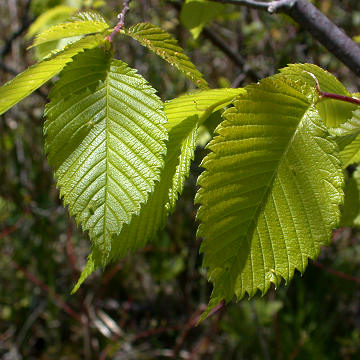

Ulmus americana - (image 1 of 5)
Taxonomy
Family: Ulmaceae
Habitat
Rich woods. Wooded floodplains.
Associates
Distribution
Nova Scotia and Quebec west to Saskatchewan, south to FL and TX.
Morphology
Deciduous tree with arching branches to 40 m. Branchlets not corky-ridged; twigs smooth or short-hairy; mature buds longer than wide and distinctly pointed, glabrous or minutely puberulent. Leaves alternate, 8-14 cm, glabrous to scabrellous above, pinnately veined, symmetrical to asymmetrical as the base, doubly serrate. Flowers perfect, in loose fascicles, on unequal pedicels to 2 cm; calyx campanulate, oblique, lobed; stamens 5-9; stigmas white. Fruit a flat, 1-seeded, elliptic, 1 cm, densely ciliate samara, the side glabrous and strongly reticulate.
Notes
Flowers appearing before the leaves, from March to early May
Wetland indicator: Facultative Wetland -
Was once a very popular street tree until an introduced pathogen, Ceratocystis ulmi (Dutch Elm Disease) decimated most large wild and planted American Elms. Small trees can still be found in the wild and some manage to get large enough to set fruit. Ulmus rubra is similar but has rather short, blunt buds and sessile or subsessile flowers and fruit on short, stout pedicels.
References
Gleason, Henry A. and A. Cronquist. 1991. Manual of Vascular Plants of Northeastern United States and Adjacent Canada. Second Ed.
The New York Botanical Garden. Bronx, NY
Swink, F. and G. Wilhelm. 1994. Plants of the Chicago Region.
Indiana Academy of Science. The Morton Arboretum. Lisle, Illinois.
|
Michael Hough © 2009 |